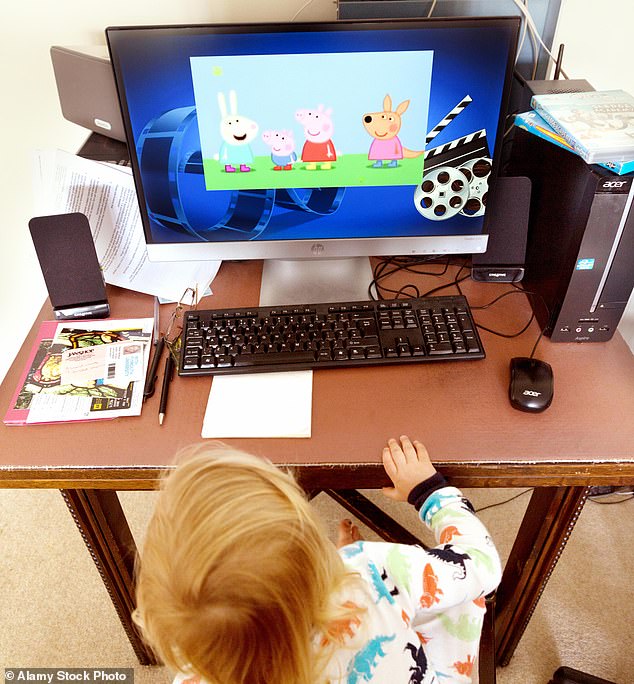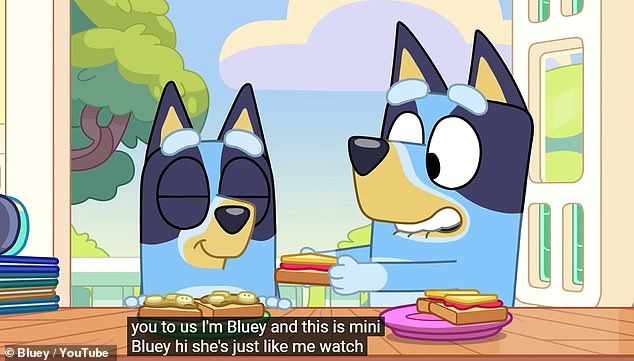Parents should turn on TV subtitles on shows like Peppa Pig and Paw Patrol to help their kids learn to read, experts say
Letting your child watch TV for hours on end may not seem like the best thing for his or her education.
But scientists say it could actually improve their reading skills – as long as you turn on the subtitles.
Researchers found that children aged four to seven are twice as likely to become good readers if they watch TV with closed captioning turned on.
And popular cartoons like Peppa Pig and Bluey even contain a large number of ‘high frequency words’ that can help your child progress with reading.
Henry Warren, co-founder of the Turn on the Subtitles campaign, said: ‘I think of it as a bit like sneaking vegetables into dinner – the kids don’t notice, but you know you’re doing them the world of good . .’
Researchers say watching cartoons like Peppa Pig could be good for your kids, as long as you turn on the subtitles

Peppa Pig is the best show for you kids to watch because it uses the most ‘high frequency words’ that kids can learn to recognize (file photo)
It is estimated that British children watch an average of 3 hours and 16 minutes of TV every day.
However, scientists say this isn’t a waste of time, as long as parents remember to turn on the subtitles.
Mr. Warren told it The times: ‘Switching on the subtitles can give children the opportunity to increase their vocabulary and make them proficient readers.
‘If you turn on the subtitles, within a year children will “read” the same number of words as in all the Harry Potter, Narnia and Lord of the Rings books, as well as everything Roald Dahl wrote.’
The science behind this unexpected benefit relies on the fact that subtitles cannot be easily ignored while they are on screen.
A groundbreaking 1997 study by researchers at the University of Leuven found that both children and adults exhibit ‘automatic reading behavior’.

Children aged four to seven improved their reading skills after watching popular children’s programs such as Bluey with the subtitles on
This means that when subtitles are playing on the screen, anyone watching can’t help but watch and follow along.
Because children already follow the subtitles, even if they cannot yet read them, they build the association between the sounds and the written words.
Research shows that this helps children develop reading skills more quickly than they would otherwise have done, especially if they may not read much in print.
These mechanisms are most effective when the words in the subtitles are words that children often encounter.
Researchers from educational software maker Access Education analyzed transcripts of 1,000 episodes of the most popular children’s TV shows.
They found that Peppa Pig came out on top as the show with the highest number of high-frequency words.
On average, 50 percent of the 100 most common words appeared in each episode of the popular children’s cartoon.

Campaigners say watching TV shows like Thomas and Friends with subtitles could double the chances of children becoming strong readers
This was closely followed by Bing and Bluey, with 49 percent of the most common words appearing in each episode.
Fireman Sam also scored very high, with 48 percent of the 100 most common words appearing in each episode.
An Access Education spokesperson said: ‘Shows such as Peppa Pig, Bing and Bluey can help children become more confident in reading and, when viewed with subtitles, can double the chances of children leaving school as competent readers.’
This month, Turn on the Subtitles launched its latest campaign with Access Education, calling on 40 million households to make the change.
Ultimately, Turn on the Subtitles wants one billion children to use subtitles on TV by the end of 2027.
Their campaigns have already led to the launch of Sky Q’s Literacy Zone, which plays children’s favorite cartoons with subtitles.
This latest campaign features a message of support from Kung Fu Panda star Jack Black.
In a video, Jack Black said: ‘Just press the button and you will blow their little minds with knowledge. They will learn to read without even realizing it. ‘
